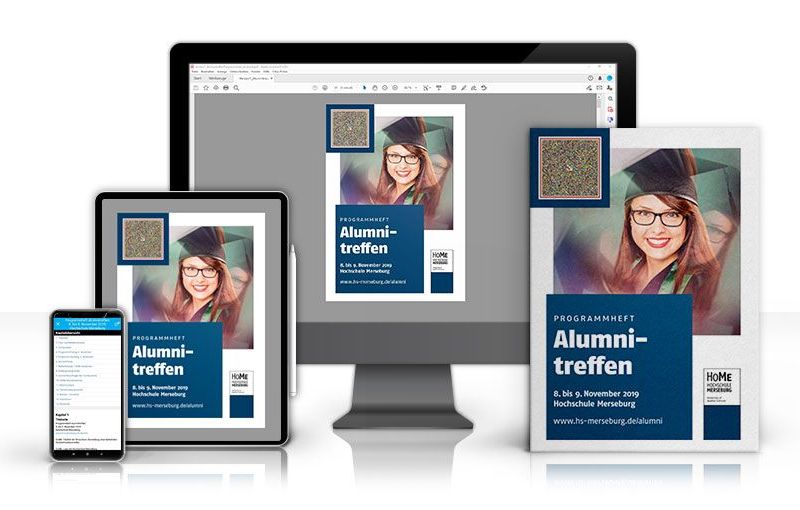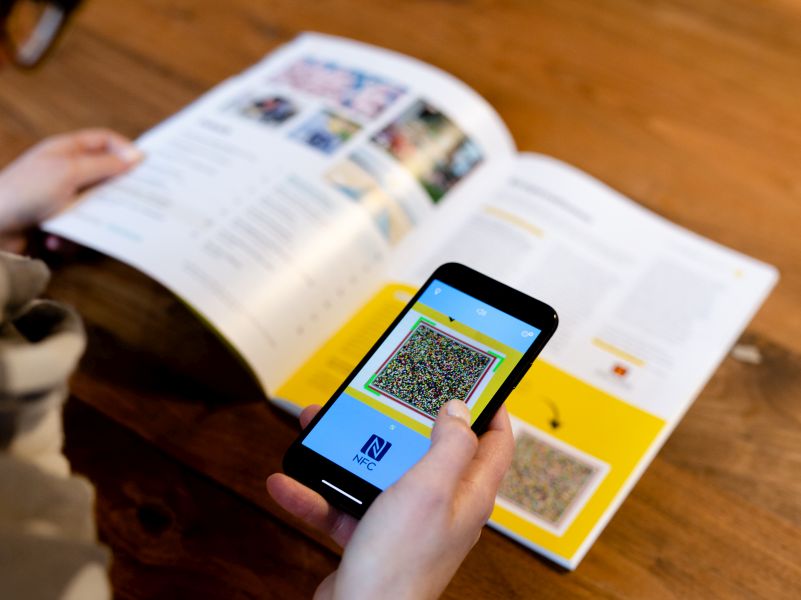Anyone, who has ever faced the task of designing an accessible brochure, knows: It’s a science!
No wonder that the accessible brochure has now even become the subject of a master’s thesis. Enrico Holzheuser, a graduate of the University of Merseburg, wrote his master’s thesis on the topic of “Accessible graphic design – designing an accessible brochure for people with visual impairments on the occasion of the alumni meeting of the University of Merseburg“.
His findings are also helpful for practitioners. The complete paper with all details is available in the download section to the right of this text (in German only). And for those in a hurry, here is an overview:
This research question is anything but trivial: “How can the information medium “brochure” be designed and made accessible for the target group of visually impaired people?”
In the first part of the paper there is info on the problem and the legal framework, as well as the definition of the sub-research questions:
The goal is an accessible printed brochure that looks good and provides accessible content for people with and without visual impairments.
The main focus is on the graphic design.
It is well known that fonts, font sizes, character and line spacing, colors and contrasts play an important role in accessibility for people with visual impairments.
In this thesis, however, these points are additionally supported with the corresponding DIN/ISO standards.
Basically, this thesis shows one thing: designing an optimally accessible brochure requires a lot of know-how and time.
Accessible graphic design requires expertise!
That’s why most companies and public agencies rely on experts, who design print media accordingly or check them for accessibility, such as leserlich.info, a service offered by the German Association for the Blind and Visually Impaired.

This is the accessible brochure for the alumni meeting
When it comes to an accessible brochure, the accessible PDF is a highly popular solution.
This is because so-called screen readers can simply read out the content of a PDF. Of course, this is only possible if the target group has Internet access, a smartphone, tablet or PC, and screen reader software.
The paper presents in great detail how to create an accessible PDF from a source text using InDesign:
Which legal requirements and standards apply, which tools are available, how and where to set tags, for example. And how to handle text structures, links, tables, images and graphic elements. And of course, how to check the accessibility of all elements of a PDF.
Quote: “The implementation effort increases with the use of complex lists, tables and form fields. For non-experts, especially the analysis of the errors found and solving them poses great problems, since workarounds could not be found for all errors to solve them.”
An included SpeechCode is a simple alternative to complex PDFs for the accessible brochure. And it has the advantage that people with and without visual impairments can use the same print medium – without Internet access. And can enjoy the comfort of just having to listen.
According to the master’s thesis, “from a designer’s point of view, the simplicity of the SpeechCode implementation is very positive. Compared to a conversion into an accessible PDF, a brochure can be converted much faster with a SpeechCode.”
Of course, the “usability tests” of all variants with the target group were scientifically recorded and evaluated.
SpeechCode was particularly happy with the additional feedback: “I liked the SpeechCode version best. Without VoiceOver, I can super enlarge the font there. The navigation is easy and friendly to use.”

Whether listening to the read-out or reading in large font – SpeechCode makes even an entire magazine accessible. Meine Reisewelt
Why accessible information in text AND speech can increase the reach of your message by up to 50 %.
read moreCommunicating nature with interactive activities
read moreHow print media gain more reach with accessiblity
read moreZeroCon23 - THE event for the accessibility topic
read moreHow climate-friendly is the internet?
read moreAudible manuals have many advantages over printed editions
read moreWhy Universal Design instead of special solutions is the right approach for inclusion
read moreRead the latest SpeechCode blogs and news on the topics Universal Design, Customer Focus and Digitalisation.
read more